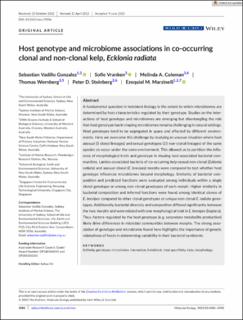| dc.contributor.author | Vadillo Gonzalez, Sebastian | |
| dc.contributor.author | Vranken, Sofie | |
| dc.contributor.author | Coleman, Melinda A. | |
| dc.contributor.author | Wernberg, Thomas | |
| dc.contributor.author | Steinberg, Peter D. | |
| dc.contributor.author | Marzinelli, Ezequiel M. | |
| dc.date.accessioned | 2023-11-21T13:29:32Z | |
| dc.date.available | 2023-11-21T13:29:32Z | |
| dc.date.created | 2023-06-30T09:43:31Z | |
| dc.date.issued | 2023 | |
| dc.identifier.citation | Molecular Ecology. 2023, 32 (16), 4584-4598. | |
| dc.identifier.issn | 0962-1083 | |
| dc.identifier.uri | https://hdl.handle.net/11250/3103870 | |
| dc.description.abstract | A fundamental question in holobiont biology is the extent to which microbiomes are determined by host characteristics regulated by their genotype. Studies on the interactions of host genotype and microbiomes are emerging but disentangling the role that host genotype has in shaping microbiomes remains challenging in natural settings. Host genotypes tend to be segregated in space and affected by different environments. Here we overcome this challenge by studying an unusual situation where host asexual (5 clonal lineages) and sexual genotypes (15 non-clonal lineages) of the same species co-occur under the same environment. This allowed us to partition the influence of morphological traits and genotype in shaping host-associated bacterial communities. Lamina-associated bacteria of co-occurring kelp sexual non-clonal (Ecklonia radiata) and asexual clonal (E. brevipes) morphs were compared to test whether host genotype influences microbiomes beyond morphology. Similarity of bacterial composition and predicted functions were evaluated among individuals within a single clonal genotype or among non-clonal genotypes of each morph. Higher similarity in bacterial composition and inferred functions were found among identical clones of E. brevipes compared to other clonal genotypes or unique non-clonal E. radiata genotypes. Additionally, bacterial diversity and composition differed significantly between the two morphs and were related with one morphological trait in E. brevipes (haptera). Thus, factors regulated by the host genotype (e.g. secondary metabolite production) likely drive differences in microbial communities between morphs. The strong association of genotype and microbiome found here highlights the importance of genetic relatedness of hosts in determining variability in their bacterial symbionts. | |
| dc.language.iso | eng | |
| dc.title | Host genotype and microbiome associations in co-occurring clonal and non-clonal kelp, Ecklonia radiata | |
| dc.title.alternative | Host genotype and microbiome associations in co-occurring clonal and non-clonal kelp, Ecklonia radiata | |
| dc.type | Peer reviewed | |
| dc.type | Journal article | |
| dc.description.version | publishedVersion | |
| dc.source.pagenumber | 4584-4598 | |
| dc.source.volume | 32 | |
| dc.source.journal | Molecular Ecology | |
| dc.source.issue | 16 | |
| dc.identifier.doi | 10.1111/mec.17056 | |
| dc.identifier.cristin | 2159698 | |
| cristin.ispublished | true | |
| cristin.fulltext | original | |
| cristin.qualitycode | 2 | |
